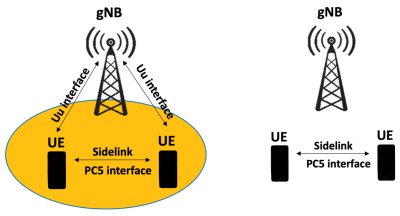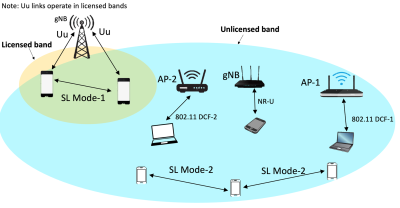Vijitha Weerackody, Kent Benson, and Sumit Roy
Published: 24 Feb 2023

CTN Issue: February 2023
A note from the editor:
When a mobile device communicates in a cellular network, data is typically going in both uplink (UL) and downlink (DL) directions to a transceiver entity generally known as a basestation. Starting with 4G LTE Advanced, and continuing with 5G, standards have been developed to allow devices to communicate with each other directly (Sidelink or SL), with and without the assistance of the traditional cellular network. One can immediately see the potential of this capability where infrastructure cellular coverage is poor or non-existent, e.g., in unpopulated areas or underground or where fast connectivity is needed for certain applications like autonomous vehicles. One can also anticipate the technical challenges in establishing sidelinks - search, acquisition, registration, authentication, radio resource allocation, etc.
In this month's article, the authors provide us with an overview of the development of 5G Sidelink, scenarios, challenges, technical approaches, co-existence with adjacent wireless technologies, and potential applications. The technological roadmap and the current Work Items in 3GPP for this very promising capability are also covered. We hope you enjoy this informative trip down the Sidelink lane.
Weimin Liu, CTN Associate Editor
Sidelink: A Technology for Infrastructureless Communications



Introduction
Sidelink is a 3rd Generation Partnership Project (3GPP) standardized technology that enables direct user-to-user communications, with or without the assistance of a base station. Current sidelink (Release 16) has evolved from the device-to-device communication system developed for proximity services (ProSe) targeting public safety via the emergency first responder community (e.g., FirstNet [1]). Sidelink is attractive in such uses because it provides support for users needing data connectivity with ultra-low latency and high reliability requirements. These characteristics are also useful in a variety of other scenarios – such as coverage extension to planned cellular networks, connectivity for Vehicle-to-Everything (V2X), communications for augmented/virtual reality (AR/VR) devices, and network support for intra-body sensors – leading to interests in expanding sidelink usage. In view of these emergent applications, 3GPP is currently developing Release 18 to further enhance sidelink technology.
![Figure 1: Illustrative use cases of sidelink: underground parking lot (left-side figure, from [2]); V2X scenario (right-side figure, from [3]).](/sites/default/files/styles/400wide/public/images/2023-2023-02/ctn-feb-2023-figure1.png?itok=rf40zHH5)
Figure 1 shows examples where sidelink is used to extend coverage of the cellular network [2] and in supporting connectivity of nodes in a V2X network [3]. Due to propagation conditions, cellular coverage is not available in the underground parking area shown on the left-side figure. Hence, the vehicles in the parking area use sidelink to connect to the street level vehicle, which functions as a relay node to the cellular network. Examples of similar use cases of sidelink to extend coverage apply in challenging infrastructure scenarios (e.g., sewers, transit tunnels, underground caves/mines), and in numerous rescue operations [2].
The right side of Figure 1 shows sidelink1 use in Vehicle-to-Infrastructure (V2I), Vehicle-to-Pedestrian (V2P) and Vehicle-to-Vehicle (V2V) links within a V2X network that are currently authorized to operate in the Intelligent Transport Systems (ITS) (5895 – 5925 MHz2 in the USA) band. In [5], V2X use cases are grouped into several different categories - safety, vehicle operations management, autonomous driving and platooning - and service-level requirements specified. Performance requirements in terms of message sizes, data rates, latencies etc., to support some of these use cases are specified in [6].
Current Sidelink Technology
Current sidelink technology is standardized in 3GPP Release 16 and operates in modes 1 and 2, where both modes support direct communication among multiple User Equipment (UEs). Figure 2 shows the key difference in these operational modes: in mode 1 the resources used by the UE-to-UE link are allocated by the base station (gNB); in mode 2 a common resource is autonomously shared between the UEs without the intervention of the gNB. As shown, mode 1 operation requires that the UEs have direct connectivity to the gNB via the Uu interface and scheduling of the resources for the UE-to-UE link is accomplished by the gNB via this link.

Sidelink mode 2 uses a distributed, self-allocation scheme to autonomously select and share the resources among the UEs. Using a semi-persistent scheduling (SPS) scheme, the transmission resources of the UEs are scheduled in a periodic manner in mode 2. When selecting the transmission resources of a particular UE, this known periodicity is used by the UE to predict, and avoid, the reserved resources by other UEs. Figure 3 shows the key aspects of the resource selection scheme for mode 2; the reader is referred to [7, 8] for further details. The key elements are the sensing window and the selection window with three UEs (A, B and C) seeking to identify available communication resources for future transmission within the sensing window. Transmissions occur in frequency resources that are reserved by the specific UEs in the time slots shown in this figure, and each such frequency resource contains data in a Transport Block (TB). Resources reserved by UE A ends before the slot n shown, hence, UE A selects new transmission resources at slot n by sensing within the (pre-specified) sensing window. Sidelink transmissions occur with periodicity specified by the values in the set Resource Reservation Interval (RRI) which are known to all UEs. The periodicities of the transmissions of UEs A, B and C are shown as RRI1, RRI2, and RRI3, respectively. As part of the resource selection process, UE A excludes the half-duplex slots (X) and the other UE reserved resources (Y) shown in this figure. Because of half-duplex operation the UE cannot sense other UE transmissions that may occur in its own transmission slots; hence, it assumes, conservatively, that other UEs would have been transmitting in such slots and excludes slots in the selection window (shown as X) that correspond to all possible RRI values. The resources that remain after these exclusions are then sent to the MAC layer for the final selection of UE A's resources.

The currently standardized sidelink supports many features including traffic priorities, open-loop power control, hybrid automatic repeat request (HARQ) feedback, and unicast, groupcast and broadcast transmissions, and the reader is referred to [7] for further details.
Enhanced Sidelink Technology
Enhanced features for the sidelink and the standardization of technologies to support these features are currently being developed for 3GPP Release 18 with work toward this release expected to be completed by June 2024. The scope of the sidelink technology development work at 3GPP is described in the following Work Items:
- NR sidelink evolution [9]. This addresses sidelink operation in the unlicensed bands, support for operation at FR2 frequencies3 including beam management, and carrier aggregation techniques to operate in multiple frequency channels.
- NR sidelink relay enhancements [10]: This establishes techniques for supporting UE-to-UE and UE-to-Network relaying.
- Expanded and improved NR positioning [11]: Supports positioning for the sidelink in both in-coverage and out-of-coverage scenarios.
Sidelink in unlicensed bands. 3GPP has prioritized developing and standardizing this technology which is one of the objectives of the NR sidelink evolution Work Item. This is because spectrum regulators in some parts of the world have recently authorized the use of the 5 and 6 GHz bands for unlicensed operations [12 - 14]. The unlicensed band is shared by many systems that use different technologies including the IEEE 802.11 system and the 3GPP standardized New Radio (NR-U) system. The latter system is a gNB-based system that is standardized in Release 16 [15] with its channel access mechanism designed for fair coexistence with IEEE 802.11 systems. To ensure fair coexistence with other systems, the Work Item on the enhanced sidelink specifies that sidelink should also use the channel access mechanism already specified for the NR-U system. This is challenging because sidelink uses its own channel access mechanism that autonomously allocates resources among the users. Current work at 3GPP is aimed at using the NR-U channel access mechanism with sidelink while preserving the autonomous resource allocation features of it.

Figure 4 shows the sidelink sharing the unlicensed band spectrum with two separate IEEE 802.11 systems (AP-1 and AP-2) and an NR-U system. The channel access mechanisms for the IEEE 802.11 and the NR-U systems are shown as 802.11 DCF-1, 802.11 DCF-2, and NR-U, respectively. Sidelink operations in mode 1 and mode 2 are shown as SL Mode-1 and SL Mode-2, respectively. As stated in this Work Item, for sidelink mode 1 operation the UEs should be connected to the gNB using the spectrum in the licensed band but direct connection between the UEs (SL Mode-1) is using the unlicensed band.
Other topics in the NR sidelink evolution Work Item. 3GPP is studying supporting the enhanced sidelink at FR2 range which requires developing dynamic beam management techniques. In addition to the advantage of accessing the large spectrum resources available at FR2, the directive nature of the sidelink network at these frequencies will significantly increase the line-of-sight range and the user-capacity of the network. Because the current sidelink does not support directive/sectored beams, the beam management techniques developed for the FR2 frequencies would also be useful for applications at lower frequency ranges.
Carrier aggregation (CA) is another sidelink feature that is under consideration at 3GPP. Sidelink resource allocation scheme is based on the availability of contiguous frequency resources – however, there are many situations where the spectrum is not contiguous. The CA feature is useful to operate in multiple frequency channels that are not contiguous in the frequency domain.
NR sidelink relay enhancements Work Item [10]. Only limited sidelink relaying techniques are currently being standardized in Release 17; thus, Release 18 is considering enhancements to these relaying techniques and several new relaying scenarios. While there are many uses for multiple hops in UE-to-UE relaying, because of the extensive work load at 3GPP meetings, only the single hop relaying shown in Figure 5 is under consideration presently.

The UE-to-Network relay is useful in many applications including in power-constrained wearable devices that use a higher-power relay UE to reach the network. The remote UE in the middle figure can be either out-of-coverage or in-coverage, whereas in the multi-path scenario shown in the right-side figure the remote UE should be in-coverage. The multi-path scenario is useful in situations when the remote UE does not have sufficient transmit power to meet the data rate requirements when using a direct link to the gNB. The relative positions of the UEs in the UE-to-Network relay will not be fixed because of mobility of the UEs. Hence, solutions to service continuity when the UE is switching to a different relaying UE and/or to a different gNB including the following are currently being developed: switching from remote UE ↔ relaying UE-A ↔ gNB-X to remote UE ↔ gNB-Y; and switching from remote UE ↔ relaying UE-A ↔ gNB-X to remote UE ↔ relaying UE-B ↔ gNB-Y [10].
NR sidelink positioning [11]. In [13, 14] target positioning requirements and potential techniques for achieving these requirements have been studied for applications in V2X, public safety, Industrial Internet of Things (IIOT) and commercial use cases. Depending upon the application, the accuracy required ranges from a sub-meter to a few meters, where the requirements should be met under in-coverage, partial coverage4, and out-of-coverage scenarios. A specific class of signals - Sidelink Positioning Reference Signals (SL PRS) - are used in sidelink to estimate position and it is concluded in [13] that a very large bandwidth (about 100 MHz) is required for the SL PRS to achieve the target requirements. In V2X applications sidelink is used to obtain estimates for both the absolute and relative position [15] as illustrated in Figure 6.

On the left-side figure, the vehicle is estimating its position using SL PRS messages sent by the fixed Roadside Unit (RSU). These measurements are then sent to the network to obtain more accurate position estimates. The middle figure shows a scenario when the vehicle does not rely on the network to estimate its absolute position. On the right-side figure an example is given when the sidelink is used to estimate the relative positions with respect to each vehicle and with respect to a Vulnerable Road User (VRU).
Next-Generation Sidelink Technology
To meet the growing market needs for infrastructureless wireless applications, sidelink is rapidly evolving with significant enhancements to the underlying technology occurring every few years. The next-generation sidelink presents opportunities for research and standardization in many areas including in pricing policy, mesh networking and security aspects. The licensed spectrum is usually auctioned off to cellular operators; therefore, for the sidelink to operate in this spectrum a suitable pricing policy has to be devised that would benefit the incumbent spectrum investors [16]. Such pricing policies are essential for the growth of sidelink-based applications. A natural extension of the sidelink network is a Vehicular Ad-hoc NETwork (VANET). The VANET could be used to provide communication needs of the vehicle passengers, without relying on the cellular network, by relaying the messages via neighboring vehicles to reach the RSU units (which are connected to the network) that are placed a few kms apart.
Although sidelink started about a decade ago as a side communication link to the main cellular-based link, in view of the rapid growth of sidelink-based applications, it is possible to anticipate a change of roles for these links in the future.
1 PC5 is the interface that supports sidelink.
2 The International Telecommunications Union (ITU) recommends harmonization of the ITS spectrum in the frequency range 5850 – 5925 MHz [4].
3 FR2 frequency range is 24.25 – 71.0 GHz.
4 In partial coverage scenario, the remote UE in the middle figure of Figure 5 is outside the coverage area.
References
- Wikipedia, “First Responder Network Authority — Wikipedia, the free encyclopedia.” https://en.wikipedia.org/wiki/First_Responder_Network_Authority (accessed 20-Jan-2023).
- 3GPP TR 22.839: "Study on Vehicle-Mounted Relays."
- 5GAA, "A visionary roadmap for advanced driving use cases, connectivity technologies, and radio spectrum needs," White Paper, September 09, 2020.
- International Telecommunications Union. Recommendation ITU-R M.2121-0. "Harmonization of frequency bands for Intelligent Transport System in the mobile service," Jan. 2019.
- 5GAA, "C-V2X use cases. Methodology, examples and service-level requirements," White Paper, June 19, 2019.
- 3GPP TS 22.186: "Service requirements for enhanced V2X scenarios."
- M. H. C. Garcia et al., "A Tutorial on 5G NR V2X Communications," in IEEE Communications Surveys & Tutorials, vol. 23, no. 3, pp. 1972-2026, third quarter 2021.
- 3GPP TS 38.214: " Physical layer procedures for data."
- OPPO, "WID revision: NR sidelink evolution," RP-222806. 3GPP TSG RAN Meeting #98-e, December 12 – 16, 2022.
- CMCC, CATT, "Revised WID: NR sidelink relay enhancements," RP-223050. 3GPP TSG RAN Meeting #98-e, December 12 – 16, 2022.
- Intel Corporation, CATT, Ericsson, "New WID on expanded and improved NR positioning," RP-223549. 3GPP TSG RAN Meeting #98-e, December 12 -16, 2022.
- 3GPP TS 37.213: "Physical layer procedures for shared spectrum channel access."
- 3GPP TR 38.859: "Study on expanded and improved NR positioning."
- 3GPP TR 38.845: "Study on scenarios and requirements of in-coverage, partial coverage, and out-of-coverage NR positioning use cases."
- 5GAA, "System architecture and solution development; high-accuracy positioning for C-V2X," Technical Report, February 9, 2021.
- M. N. Tehrani, M. Uysal and H. Yanikomeroglu, "Device-to-device communication in 5G cellular networks: challenges, solutions, and future directions," in IEEE Communications Magazine, vol. 52, no. 5, pp. 86-92, May 2014.
Statements and opinions given in a work published by the IEEE or the IEEE Communications Society are the expressions of the author(s). Responsibility for the content of published articles rests upon the authors(s), not IEEE nor the IEEE Communications Society.


